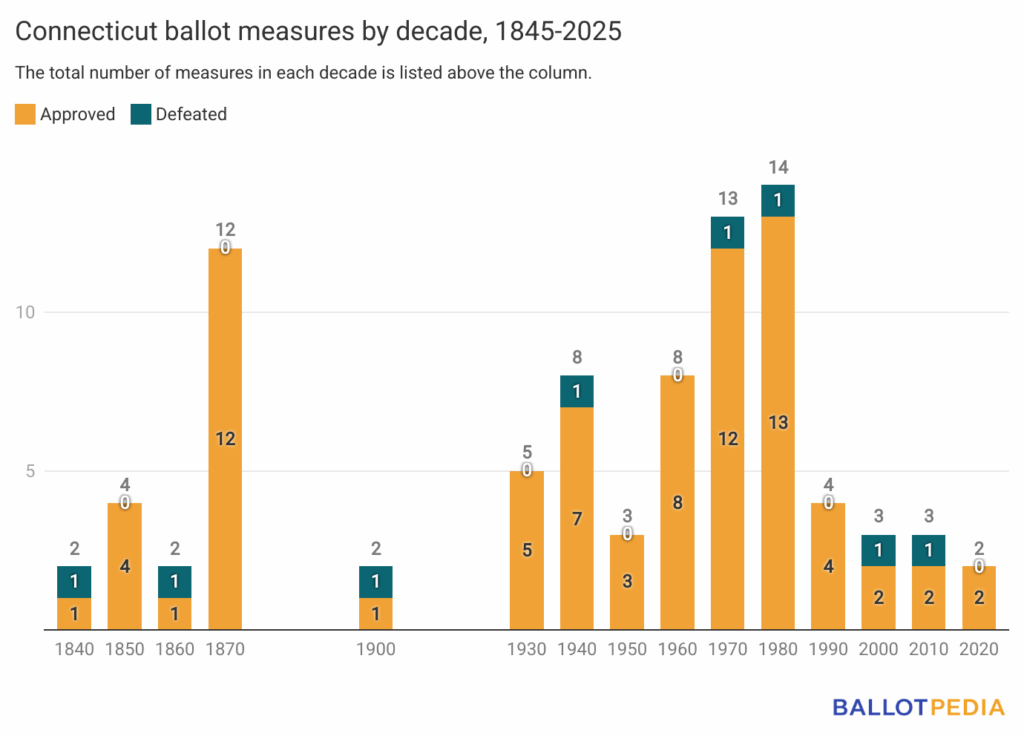Since 1845, Connecticut voters have decided 85 statewide ballot measures. Of these, 77 (90%) were approved, and 8 (10%) were defeated.
In Connecticut, the General Assembly can refer measures to the ballot. Citizens of Connecticut do not have the power to initiate statewide ballot measures, and the state has never voted on an amendment to authorize the initiative and referendum process.
Ballot measures can also come in the form of an automatic constitutional convention question, which appears on the ballot every 20 years per the Connecticut Constitution. Alternatively, the legislature can refer a constitutional convention question to the ballot. If a state constitutional convention is held, any amendments approved by delegates would be placed on the ballot for voters to decide.
While the majority of ballot measures have been legislatively referred constitutional amendments — with a total of 79 of 85 (93%) measures — Connecticut residents have also voted on two advisory questions; two automatic constitutional convention questions; one legislatively referred constitutional convention question; and one constitutional convention referral.
Throughout Connecticut's history, 74 (94%) of the legislatively referred constitutional amendments, both advisory questions, and the one legislatively referred constitutional convention question were approved. Neither the constitutional convention questions, nor the single constitutional convention referral were approved.

Connecticut ballot measures have addressed 48 unique topics, ranging from redistricting policy to the salaries of government officials. The most common topics that appeared on the ballot have been voter registration (nine measures), voting age policy (eight measures), and state judicial selection (eight measures).
Below is a selection of the notable ballot measures in Connecticut's history. For a more comprehensive list, see here.
- In 1845, voters approved an amendment that established that qualified electors must be a white male; 21 years of age; a resident in the state for at least one year; a resident in their town for at least six months; and sustain a good moral character.
- Voters defeated two amendments, Question 1 in 1847 (21.9%) and Question 1 in 1865 (44.8%), that would have removed the race requirement to become an elector.
- In 1855, voters approved a ballot measure requiring electors to be able to read any article of the state constitution or state statute.
- After the 15th Amendment was ratified in 1870, the race requirement to become an elector was officially removed from the Connecticut Constitution in 1876 when voters approved an amendment (by 86.1%) that removed the word 'white' from the list of qualifications.
- Question 1, which would have permitted the legislature to pass laws to provide for fewer requirements for early voting and eligibility to cast absentee ballots, was defeated by voters in 2014.
- The Connecticut General Assembly was authorized to pass laws to provide for early voting in person when voters approved Question 1 in 2022.
- In 2024, voters approved a measure that authorized the state legislature to pass laws to provide for no-excuse absentee voting, with about 58% of voters approving it.
Of the 85 statewide ballot measures in Connecticut, only one was decided by less than one percentage point of the vote. The measure — Question 2 — removed party levers from voting machines and was approved in 1986, with 302,899 (50.4%) voting 'Yes' and 297,827 (49.6%) voting 'No', leaving a margin of 0.8%.
The measure with the widest margin, at 96.9%, was Question 2 in 1876. The amendment, which moved the election date for state officials from April to November to coincide with Election Day, received 31,871 (98.4%) Yes and 503 (1.6%) No votes.
On average, Connecticut voters have decided on roughly five ballot measures per decade. The 1980s had the most ballot measures within a single decade, with 14. Of these, 13 (93%) were approved and one (7%) was defeated. The decades with the highest approval rate (all at 100%) were the 1850s (four measures), 1870s (12 measures), 1930s (five measures), 1950s (three measures), 1960s (eight measures), and the 2020s (two measures). The decades with the lowest approval rate (all at 50%) were the 1840s, 1860s, and the 1900s.

The inventory of Connecticut statewide ballot measures is part of Ballotpedia's Historical Ballot Measure Factbook, which will document nearly 200 years of direct democracy in the United States. This ongoing research effort will provide an unparalleled resource for researchers, reporters, and the voting public on how ballot measures have evolved, the issues they've covered, and the role they have played in our civic life.
Additional reading:


